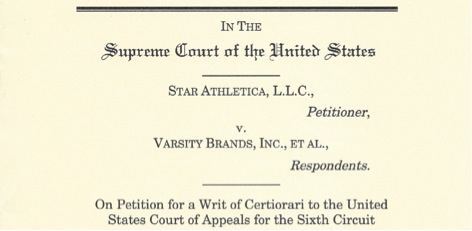Juelsgaard Clinic Students Ask Supreme Court to Hear Appeal to Establish a Clear Copyright Rule to Facilitate 3D Printing

Juelsgaard IP and Innovation Clinic students Sydney Lakin ’17 and Bill Koch ’17 drafted and submitted an amicus brief to the Supreme Court earlier this quarter urging it to hear an appeal in VarsityBrands v. Star Athletica. The case addresses a significant unanswered question in copyright law: how to define conceptual separability — the idea that creative elements of useful articles can be copyrighted if they are conceptually separable from the utilitarian aspects of the article. The case on appeal involves the question of which elements of cheerleading uniforms are protectable by copyright and which are not, but the Clinic’s brief explains to the Court that continued uncertainty around separability threatens wide-ranging consequences far beyond cheerleading uniforms. In particular, the brief argues, uncertainty in copyright law represents a serious impediment to continued innovation in and adoption of 3D printing technologies. Uncertainty leads to a tendency to over-categorize items as copyrightable, the chilling of new development and distribution, the creation of unnecessary, wasteful legal costs, and the deterrence of new entry into 3D printing markets.
Among the topics students in the Juelsgaard Clinic explore in their seminar sessions is the various roles that amicus briefs can play in appellate proceedings and the different types of amicus briefs submitted for those purposes. The VarsityBrands submission is an example of a brief that explains to a court how a case and issue will have a broader impact on or affect industries beyond the one directly at issue in the case. The Juelsgaard brief focuses specifically on the interaction between separability and the 3D printing industry as well as innovation generally.
Conceptual separability is the principle that creative components of useful articles can be copyrighted if they are conceptually separable from the utilitarian aspects of the article. For example, a wrench is not copyrightable because it is entirely functional (although it may be protectable by a patent). On the other hand, a sculpture usually is entirely creative and thus is protected by copyright law. Many objects fall somewhere between these two extremes, however; for example, an object like a decorated belt buckle is functional in that it keeps the belt strap secure but also has ornamental features and flourishes that make it visually attractive. Conceptual separability allows a determination of which components of the belt buckle are protected by copyright and which are not.
Unfortunately, courts have thus far failed to settle on a single test for conceptual separability, creating “a conflicting, convoluted body of law,” according to the brief. Indeed, the Sixth Circuit’s opinion identifies as many as nine distinct tests present in previous case law or proposed by academics –and proceeds to apply a tenth. The Clinic’s brief emphasizes the need for a single, clear test for conceptual separability that can be applied nationally, and the importance of such a predictable standard for the continued vitality of the burgeoning 3D printing industry. The brief was submitted on behalf of three major 3D printing companies, Shapeways, Inc., Matter and Form Inc. and Formlabs Inc, whose users are likely to be substantially affected by the current uncertainty.
